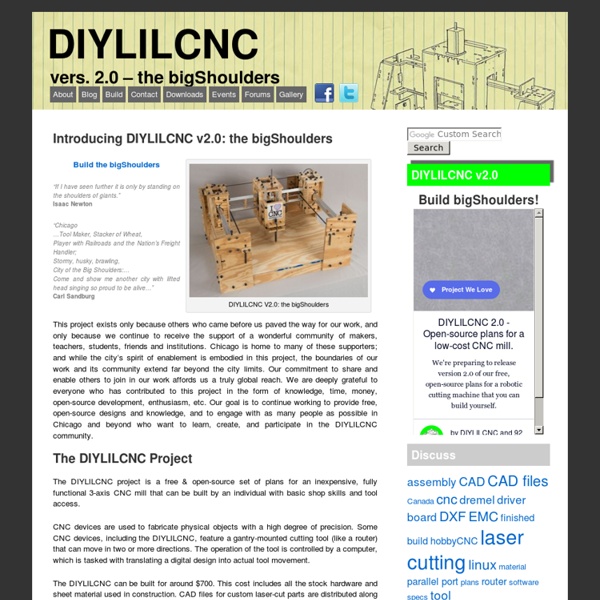



Thingiverse - Digital Designs for Physical Objects Digital Designs for Physical Objects The cat Made by PP3DP Sep 8, 2010 Source Description No description provided. Top Tweakie, Tweakie.CNC, CNC, router, mill, engraver, vinyl cutter, laser. Make CNC DIY Projects & Products | MakeCNC.com Wiki RepRap is humanity's first general-purpose self-replicating manufacturing machine. RepRap takes the form of a free desktop 3D printer capable of printing plastic objects. Since many parts of RepRap are made from plastic and RepRap prints those parts, RepRap self-replicates by making a kit of itself - a kit that anyone can assemble given time and materials. It also means that - if you've got a RepRap - you can print lots of useful stuff, and you can print another RepRap for a friend... RepRap is about making self-replicating machines, and making them freely available for the benefit of everyone. Reprap.org is a community project, which means you are welcome to edit most pages on this site, or better yet, create new pages of your own. RepRap was the first of the low-cost 3D printers, and the RepRap Project started the open-source 3D printer revolution. RepRap was voted the most significant 3D-printed object in 2017. About | Development | Community | RepRap Machines | Resources | Policy
L’impression 3D, ce sera formidable… s’ils ne foutent pas tout en l’air ! | Dico Micro L’impression 3D est en train de naître sous nos yeux. Demain il sera ainsi possible de reproduire toute sorte d’objets chez nous aussi facilement, ou presque, qu’un texte numérique se couche sur le papier à l’aide de notre bonne vieille imprimante 2D. Les conséquences potentielles de la démocratisation d’un tel outil donnent le vertige et suscitent espoir et enthousiasme parmi les makers du monde entier[1]. Pour rappel, l’impression 3D est une technique qui permet de produire un objet réel à partir d’un fichier CAO en le découpant en tranches puis en déposant ou solidifiant de la matière (plastique, cire, métal…) couche par couche pour, en fin de compte, obtenir la pièce terminée. C’est l’empilement de ces couches qui crée un volume. Si le concept et la technologie vous semblent encore un peu obscurs, je vous invite à regarder cette courte vidéo. Pour le moment on se déplace donc chez ceux qui disposent d’une telle imprimante, imprimante encore rudimentaires dans ses possibilités.
EMC² et LinuxCNC Samedi, 19 Février 2011 21:10 Benjamin Voilà une découverte qui m'a rapidement conquis. EMC² est un logiciel open source permettant d'interpréter les programmes GCode et de commander une fraise numérique CNC. Ce logiciel tourne sous linux. Lien de linuxCNC où vous trouverez le cd d'installation à télécharger gratuitement Les avantages En plus de la gratuité du logiciel, j'ai constaté rapidement que ma machine avait moins de vibration en utilisant EMC². J'ai également trouvé le logiciel très intuitif et comme nous allons le voir, configurer le programme pour commander une CNC est très simple. L'écran principal possède une vue simulée de la pièce que l'on va usiner et montre l'état d'avancement lors du travail. Le logiciel repose sur un OS récent ce qui permet l'utilisation de clé usb, du réseau, ... pour communiquer les fichiers. Configurer une machine Pour cet article, nous allons voir comment configurer une machine CNC dans EMC². 1. 2. 3. 4. 5. 6. 7. 8. Bon amusement! Liens
How to Make a Three Axis CNC Machine (Cheaply and Easily) A salute to those who have laboured through to this point (and to demonstrate that it is reproducable) Here are some pictures of other peoples machines. Photo 1 - Chris and his friend put together this unit; laser cutting the parts out of half inch acrylic. Not only does it look super it must weigh a ton. Photo 2 - Sam McCaskill has finished his desktop CNC machine and it's looking really really nice. Photo 3 - Angry Monk's - With MDF pieces cut on a laser cutter and drive converted from toothed belts to threaded rod Photo 4 - Bret Golab's - Bret has completed his and gone through the extra step of getting it setup to work with Linux CNC (a task I attempted and was foiled by complexity). (If you have built one and would like it featured here, please send me a PM and we can arrange for the sending of photos)
Generation FAB by Matthew Gardiner on Prezi Protei >> 2013/04/25, 08:00 : Barcelona, Spain>> 2013/04/18, 08:00 - April 21, 20:00 : Casablanca, Morroco>> 2012/04/06, 08:00 - April 10, 20:00 Tema (Accra), Ghana>> 2013/03/25, 08:00 - March 30, 20:00 : CAPE TOWN, SOUTH AFRICA>> 2013/03/08, 08:00 - March 18, 20:00 : Port Louis, Mauritanie>> 2013/03/06 08:00 - March 11, 20:00 : Cochin, India>> 2013/03/01, 20:00 - Feb 25, 08:00 : Rangoon, Burma>> 2013/02/20, 08:00 - Feb 21, 20:00 : Singapore>> 2013/02/12, 08:00 - February 18, 16:00 : Ho Chi Minh, Vietnam>> 2013/02/07, 08:00 - Feb 8, 20:00 : Hong Kong>> 2013/02/03 : 08:00 - Feb 4, 20:00 : Shanghai, China>> 2013/01/30, 08:00 - Jan 31, 20:00 : Kobe, Japan>> 2013/01/27, 08:00 - Jan 28, 23:00 : Yokohama, Japan >> 2013/01/15, 08:00 - 16, 20:00 : Hilo, Hawaii, USA>> 2013/01/9, 17:00 : departure from San Diego, CA, USA >> 2012/11/29 : TEDxVilaMada "Nosso Planeta Agua" Sao Paolo, Brasil >> 2012/10/18 - 28 : Protei at Lodz Design Festival, Poland. Blog Origin of the name & Biomimicry Protei Community
Main Page - partsregistry.org